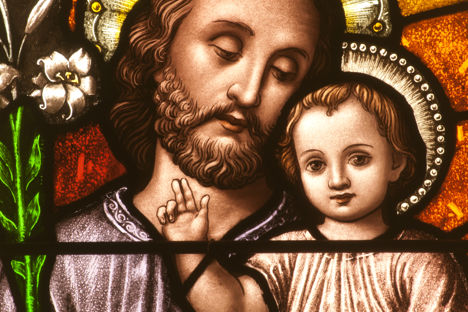
Italian Father’s Day: the feast of St Joseph
Amy Gulick introduces us to St Joseph's Day (19 March), where tables are adorned with indulgent treats and Italians give thanks to their fathers.
Italian Father’s Day: the feast of St Joseph
Amy Gulick introduces us to St Joseph's Day (19 March), where tables are adorned with indulgent treats and Italians give thanks to their fathers.
It’s almost impossible to overstate the importance of St Joseph (or San Giuseppe) in Italian culture. As the foster father of Christ and patron saint of fathers, families, workers and unborn children, St Joseph functions as a kind of symbolic paternal figure to Italian Catholics, and it is not by coincidence that his principal feast day, on 19 March, is the day Italians honour all fathers (la festa del papà).
Marked by abundance and giving, la festa di San Giuseppe is a categorically food-focused celebration of spring’s bounty. In countless communities throughout southern Italy and Sicily, the days leading up to 19 March see an ambitious and communal food-making endeavour, resulting in banquets so lavish and plentiful they seem to mock the very idea of hunger, if not vanquish it outright for the remainder of the year. No matter how many hungry guests gather round one’s table on San Giuseppe, there must always be leftovers to give to neighbours or homeless people.
At the centre of the feast is ‘St Joseph’s Table’, upon which this mountain of food will be arranged. Nothing is placed on the table by chance; every item embodies some emblematic association or auspicious end. Bread takes centre stage, as the most perfect expression of man’s toils transformed into sustenance, and recalling as well the ancient Roman grain festivals once observed at the end of winter. Sweets, particularly fried and cream-filled pastries, mean a temporary reprieve from fasting and abstinence during Lent. Flowers, asparagus, wild fennel and fava beans laid around the table speak to springtime’s imminent return, while lemons, oranges and wine represent the fruit of the preceding season’s labours. Fish-based dishes symbolise Christ, and there is usually no meat present on the table.
The countless fascinating food rituals surrounding this holiday derive from both ancient pagan and early Christian customs. In more recent centuries, thanks to Italian immigration, St Joseph festivities have taken root in other parts of the world—namely America, where Italian-American communities celebrate Saint Joseph with large, potluck-like events. Here are some of the Italian foods and lore associated with this significant feast day.
Bread
St Joseph’s day is so strongly bound to bread that in some parts of southern Italy it goes by La Mattredda, taking its name from la madia, a large wooden chest with deep drawers traditionally used in bread-making and storage. In preparation for the feast, groups of women dedicate hours to kneading and forming various bread shapes, from small, ornamental bread baskets to hefty staff-shaped loaves (to represent Joseph’s staff, which burst into bloom when Christ was born). In parts of Sicily, altars are decorated almost entirely with so-called pani votivi, or votive breads; intricately-shaped bakes in various sizes that are arranged around an image of the Holy Family. Outside the home, 'St Joseph's bread’ may be distributed from house to house or donated to the local church. Recipients of pane di San Giuseppe dedicate a special prayer to the saint.
Fried pastries
St Joseph’s feast day, being a one-day sanctioned break from the eating restrictions of Lent, is witness to much indulging in sweets. Despite their different names and regional variations, the many decadent pastries of the day are invariably fried and filled with egg cream or ricotta. These include the Florentine speciality frittelle di riso, or fried rice fritters, and the soft and spongy sfingi and ricotta-stuffed cassateddi of Sicily. In the Italian-speaking Swiss canton Ticino, fried beignets known as tortelli di San Giuseppe will be enjoyed.
Fava beans
Several spring vegetables are linked to Joseph’s feast day, yet none so strongly as the fava bean, or broad bean. According to legend, a group of drought-stricken Sicilian farmers faced sure starvation until the saint intervened on their behalf, bringing about a miraculous crop of fava beans. This otherwise lowly legume has since come to represent Joseph’s generosity and benevolence, and in honour of him fava beans will be placed around the table or cooked in various dishes. Moreover, the fava bean has earned a lucky charm status among Catholics, some of whom will attend mass with a fava bean in their pocket on the day.
Maccù di San Giuseppe
Perhaps no dish embodies the transitional nature of this holiday so well as the stew known as maccù di San Giuseppe. As the move from one season to the next is often characterised by purging and cleaning rituals, the customary emptying of the pantry around the equinox is said to account for this many-ingredient concoction. All the items of last season’s harvest—dried beans, peas, lentils, chestnuts—are tossed into the pot along with fresh greens, wild fennel and fava beans (of course). In making maccù di San Giuseppe, Italians at once honour the saint and ready the pantry for the spring-summer bounty to come.
Focaccia di San Giuseppe
In Puglia, a special kind of focaccia is made in honour of Joseph, one whose unique combination of ingredients reflects the local taste preference for things agrodolce, or sweet and sour. Anchovy, young white onions and raisins are added to a focaccia dough with a high olive oil content, which is then rolled into a spiral shape and baked. The bread likely owes its Joseph affiliation to the type of onions used, harvested this time of year before the onion bulb is fully formed and the stalk is very tender and flavourful.
Amy Gulick


